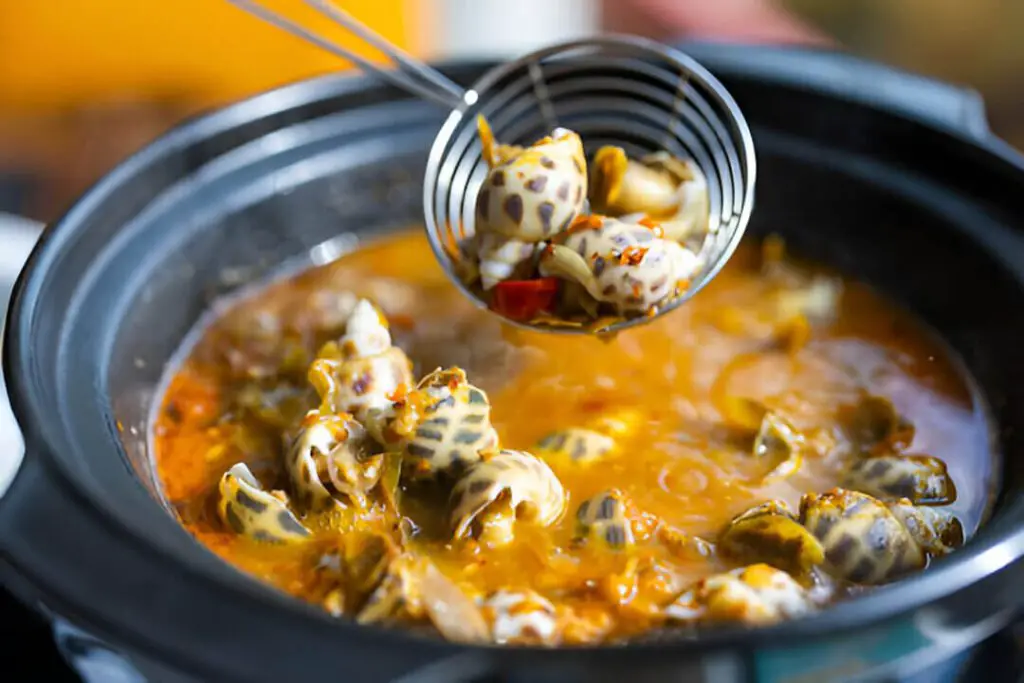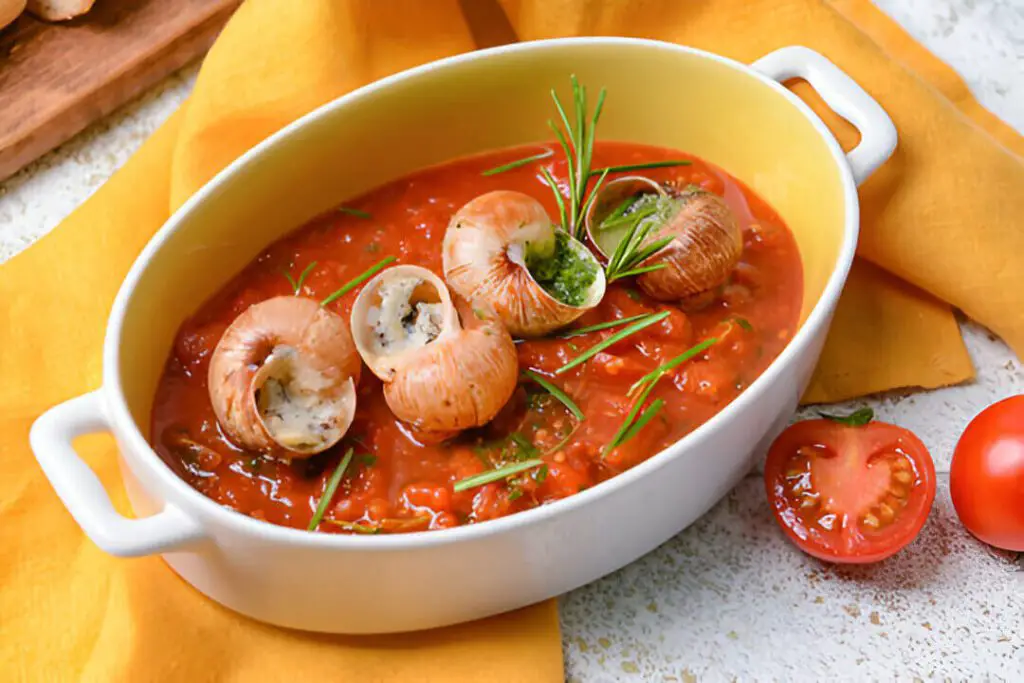You read that right; we’re diving into the peculiar world of snail cuisine! If you’re desperately curious about what these slimy backyard dwellers taste like, you’ve come to the right place. Because, let’s be honest, at some point we’ve all wondered if the humble snail is a delicacy or a dietary disaster waiting to happen.
The truth is, snails are considered a delectable treat in many cultures around the globe. But their taste and texture seem to be one of the culinary world’s best-kept secrets. Do they really taste like chicken? Are they bursting with flavor or as bland as their shells? And perhaps the biggest question of all – can you even eat them raw?!
Prepare to have your preconceptions shattered as we take you on an exploratory journey into the distinctive flavors of snails. We’ll uncover what do snails taste like, what gives them their unique taste profiles, how to cook them for maximum deliciousness, and whether you should steer clear of eating them au naturel. Snail saliva may be gross, but trust us, their taste is anything but! So slither up and get ready to indulge your curiosity about this divisive dish.
What Do Snails Actually Taste Like?
The first thing to understand is that snails don’t have an intensely powerful flavor on their own. In fact, some might even call them rather bland or mild when eaten plain. However, their true magic lies in their ability to absorb the flavors of whatever they are cooked with.
Think of a snail’s flesh as a flavor sponge just waiting to soak up the delectable tastes of herbs, butter, and any other ingredients you pair them with. On their own, snails provide a delicate base flavor that is often compared to a mix of mushrooms and mild seafood like clams or mussels. An underlying earthiness is commonly noted as well.
When it comes to texture, snails certainly don’t disappoint if cooked properly. Their meat is remarkably tender with a softness akin to well-prepared calamari when heated at the right temperature. Overcook them though, and you’ll be dealing with rubbery, chewy nuggets instead of that pleasing, melt-in-your-mouth consistency.
To get more specific, snails cooked by boiling tend to provide that quintessential light, mushroom-like flavor and soft, fleshy texture. Frying them results in a crispy outer shell giving way to a chewier meat inside with a more amplified taste thanks to the cooking oils and spices. Grilling allows the natural sugars to caramelize, adding delicious charred notes to their umami essence. And finally, baking snails in a garlic butter sauce transforms them into luxuriously creamy morsels with a punched-up flavor.
No matter the preparation, snails have an uncanny ability to take on surrounding flavors while maintaining their signature undertones of earth and sea. In French cuisine where snail dishes are traditional, they are often prepared in parsley and garlic butter to allow their essence to gently shine. But snails can be used in virtually any savory dish where you want that unique taste and tender bite.

Factors That Can Influence a Snail’s Flavor
While the cooking method plays a major role in developing a snail’s taste, there are several other factors that impact their flavor profile before they even hit the pan. Much like how terroir affects wine, a snail’s diet and environment shape its essence.
What’s on the Menu?
Snails are often described as “what they eat” in terms of how their diet translates to flavor. As indiscriminate little eaters, snails will happily munch on just about anything – plants, fruits, fungi, algae, and decaying organic matter. This means their flesh becomes a repository for all those unique tastes and compounds.
Snails that feed primarily on plants and herbs take on grassy, herbaceous notes. If their diet consists of fungi like mushrooms, you can expect an earthier, richer umami flavor. Those that favor fruits may have a subtle sweetness. And snails feasting on aquatic greenery can develop a briny, almost oceanic flavor reminiscent of the sea.
Essentially, a snail acts like a flavor sponge for its environment. So their natural taste already has nuances before any human intervention through cooking and seasoning.
A Sense of Place
In addition to diet, a snail’s home terrain plays a role in its signature taste. Snails from different regions, climates, elevations and ecosystems can develop distinctly different flavor profiles shaped by their surroundings.
For example, snails culled from coastal areas often carry a faint brininess from the salt air. Those from mountainous, forested areas may take on more earthy, woodsy essences. Urban snails could potentially absorb Notes of pollution (not appetizing). And freshwater snails versus saltwater varieties can taste completely different due to their aquatic environments.
Local lore and old wives tales around the world attest that even specific soil compositions, such as calcium-rich, chalky terrains, can impact a snail’s flavor in subtle ways. While it may sound far-fetched, a snail’s natural taste IS essentially the embodiment of its sense of place.
This concept of terroir highlights how something as simple as a snail can carry the nuanced flavors of its land and showcase that region’s unique culinary voice when treated with care. Whether you’re eating snails in Burgundy or Beijing, their taste can divinely express where they came from if you’re attuned enough to notice.
The Freshness Factor
How fresh a snail is at the time of preparation is key as well. Snails destined for the table are typically purged and fasted for a period to allow them to empty out any unappetizing bits they’ve ingested. If this process isn’t done properly though, off-flavors and bitterness from food still in their gut can taint their taste.
The same goes for snails that have remained idle and un-fed for an extended period before cooking. Their flavor will be more muted and unremarkable compared to snails plucked at their prime. Like any quality ingredient, premium snail flavor comes from those handled promptly and prepared simply without excessive cleaning periods that can dull their essence.
To Eat Raw or Not?
While most cultures that revere snails as a delicacy prepare them cooked in some fashion, there are the rare few that enjoy snacking on these mollusks in their raw, unadorned state. But is eating a snail straight out of the shell really a good idea? More importantly, what does a raw snail actually taste like if you’re brave enough to try one?
The Idea of consuming any creature raw and uncooked understandably raises food safety concerns. In the case of snails, they can potentially harbor harmful bacteria like salmonella or parasites that need to be killed off through the cooking process. However, if snails are sourced responsibly from clean environments and purged properly prior to consumption, the risk can be minimized.
For the curious and daring eating a raw snail, the first thing you’ll notice once you extract that fleshy body from its shell is the unmistakable aroma of the outdoors – a woodsy, vegetal scent reminiscent of fungi or damp soil. It’s almost as if you’re breathing in the essence of the terroir that the snail originated from.
As for the taste itself, raw snail meat is often described as having a soft, delicate flavor with subtle briny-sweet notes not unlike raw clams or oysters. The texture is remarkably tender with a smooth suppleness that yields slightly as you chew it. There can be an ever-so-slight chewiness as well, adding an intriguing contrast to the otherwise creamy mouthfeel.
Proponents of raw snail consumption tout it as the purest way to experience the snail’s primitive flavors, unmuddled by cooking methods or ingredients. The taste is simple and understated – a refined expression of the snail’s core earthiness distilled into an all-natural morsel.
That said, not everyone agrees that raw is the best way to enjoy a snail’s flavor. Many find the taste to be too mild and underwhelming when uncooked, preferring the addition of fats like butter or flavor enhancers like garlic and wine to coax out the snail’s savory potential.
There’s also the issue of food safety and proper preparation that needs to be considered. Reputable raw snail aficionados follow a regimen of vigilantly cleaning and purging the snails for several days prior by submerging them in saltwater solutions. This allows them to expel any contaminants and impurities before eating. Even then, there are still inherent risks involved with consuming any raw animal protein.
So while the experience of popping a snail’s tender, uncooked body straight into your mouth offers a uniquely primal glimpse into its unaltered essence, it’s certainly an acquired taste that may not appeal to all palates. Trying a raw snail is perhaps best left to the intrepid culinary explorer seeking the most genuine taste of nature. For the rest, cooking helps make this delicacy feel a bit more, well, domesticated and approachable.
common mistakes to avoid when preparing snails to enhance their taste

Improper preparation can quickly turn these petite delicacies from sublimely savory to dismally dull on the palate. Avoiding these pitfalls will ensure you experience snails at their unabashed best.
Using the Wrong Snails
Before you even get to cooking, you need to make sure you’re sourcing the right type of snails meant for human consumption. Many species are inedible or potentially toxic. Opt for varieties like the Petit Gris from France or Italian bourguignons that are raised and purged specifically for culinary use. Plucking them from your backyard is not advisable.
Skipping the Purge
Speaking of purging, this vital step should never be skipped when prepping snails. Purging involves submerging the snails in salted purification baths for several days and changing the water frequently. This process allows them to expel any impurities or contaminants and prevents off-flavors. Snails that aren’t fully purged can taste unpleasantly gritty or bitter.
Poor Cleaning
Even after purging, snails need to be thoroughly rinsed, scrubbed and cleaned of any residual slime or detritus clinging to their bodies and shells. Any remnants left behind can taint their fresh, delicate flavor. Take the time to properly de-slime them before cooking.
Overcooking
Like any protein, overcooking is the mortal enemy of good snail texture and taste. Snail meat is incredibly delicate, so even a couple extra minutes of cooking can render it intolerably chewy and rubbery. Follow recipes precisely and pull them from heat at the first sign of firmness.
Undercooking
On the flip side, undercooking snails leaves them unpleasantly mushy and can fail to develop their full range of flavors. Give them enough heat to firm up their bodies slightly so you get that perfect, tender texture. Undercooking also doesn’t kill any potential bacteria.
Overcrowding
When boiling, frying or baking snails, it’s important not to overcrowd the pan or pot. Having too many in at once creates an overly steamy environment that can make them rubbery. Cook them in batches if needed, ensuring maximum surface area exposure.
Excessive Seasoning
While snails brilliantly absorb flavors from fats, herbs and aromatics, you don’t want to go overboard and obliterate their delicate essence. Use a restrained hand with heavily perfumed ingredients like garlic, shallots or truffle that can steamroll their nuances. The seasoning should be a supporting act, not the headliner.
Not Removing Unwanted Parts
There are certain parts of the snail you’ll want to discard, like their rubbery feet or any unsavory muddy “deposits” left in their sac before cooking. Carefully inspect and remove anything that looks unappealizing or could impact the taste.
Stale Ingredients
Using tired, old ingredients like oxidized garlic, wilted herbs or rancid butter/oil will only impart unpleasant off-flavors to these delicate morsels. Opt for the freshest, highest quality produce and accoutrements worthy of this refined ingredient.
No Final Flourish
The most delicious snail dishes usually incorporate some form of final flavor punch – whether it’s a vibrant herb garnish, squirt of lemon, drizzle of premium olive oil or sprinkling of rustic bread crumbs. This last touch helps lift and highlight the snail’s flavors on the palate.
How Do Cooked Snails Taste?

While the idea of eating raw snails provides a primal connection to their unadorned essence, the vast majority of snail enthusiasts around the world prefer these mollusks cooked and prepared using various techniques. Not only does cooking make snails safer to consume, but it also allows their delicate flavors to fully blossom and marry with complementary ingredients.
From steaming and boiling to frying, baking, and grilling, each cooking method coaxes out different nuances in a snail’s taste profile while transforming its texture in unique ways. Let’s take a deeper dive into how the humble snail’s flavor and mouthfeel evolves through heat and culinary alchemy.
The Boiled Snail

One of the most classic preparations, boiling snails in an aromatic broth, allows you to experience their pure, unadorned flavor. As the snails simmer gently, their flesh becomes sublimely tender while still retaining a satisfying, almost bouncy bite.
The taste Itself is mild yet distinctive—an underlying earthiness complemented by nuances of mushroom umami and a delicate brininess akin to mild seafood like clams. This simple essence pairs exquisitely with garlic, fresh herbs like parsley, and a pool of clarified butter for dipping.
Fried Snail Decadence
For those who crave crunch and richness, frying snails offers a shockingly delightful textural contrast. Dipped in an egg batter and crisped up, the exterior becomes a delightfully shattering golden-brown crust that gives way to the most tender molten interior imaginable.
As the snails fry, their natural sugars caramelize, lending deeper sweet-savory notes and concentrating their mushroom-like earthiness. The judicious use of garlic, parsley, white wine or lemon zest in the batter enhances these nuances without overshadowing that signature snail taste.
Perhaps the pinnacle of fried snail enjoyment is the iconic French snail bourguignon preparation – a decadent dish of plump snails swimming in garlic-herb butter contained within a crispy pastry shell. Each mesmerizingly crunchy bite gives way to an molten, umami-packed burst of flavor.
Grilled Snails with Smoky Depth
Applying the magic of live-fire grilling adds layers of deliciousness to a snail’s flavor profile that simply can’t be replicated elsewhere. As the snails slowly cook over the smoky heat, their inherent earthiness becomes more pronounced with beguiling notes of char and caramelization.
The burst of smokiness pairs remarkably well with the snail’s natural savoriness while adding hints of toastiness evocative of nuts and mushrooms. Their texture becomes almost creamy thanks to the gentle, enveloping heat that suffuses them.
Truly mastered when grilled in the shell with generous lashings of herbed garlic butter, the smoky snails transform into lip-smacking treats with multi-dimensional flavors. For die-hard grillers, introducing a snail into their live-fire repertoire opens up a whole new realm of savory possibilities.
Baked to Bubbling Perfection

Of all the cooking methods, baking allows the snail’s flavors to meld most seamlessly with the accompanying ingredients it’s prepared with. As the snails bake slowly in their shells or baking dishes, their juices commingle with elements like garlic, shallots and herbs to create sumptuously flavored sauces.
Baking concentrates and melds those flavors while transforming the snails into incredibly rich, almost buttery soft nuggets of molten savory goodness. Each bite packs lavish, intense味with layers of deliciousness – the brininess of the snails melding with the unctuousness of aromatic butter and the savoriness of garlic and herbs.
Classic baked preparations like snails bourguignon or snails au gratin exemplify this alchemy at its finest. Delicately emerged in herbed garlic butter and breadcrumbs, the snails become creamy umami bombs that beg to be soaked up with fresh, crusty bread.
No matter the cooking method – boiling, frying, grilling or baking – each technique works its own particular flavor-enhancing magic on snails. From amplifying their pure essence to layering on flavors through aromatics, fats and smoke, the possibilities for savory exploration are endless. It’s this adaptability and culinary versatility that allows snails to harmonize so well in a variety of dishes across global cuisines.
For those who haven’t yet experienced the depth of flavors and textures attainable through cooking snails, each preparation offers a revelatory taste experience. Even the most skeptical palate is likely to be wondrously surprised by the richness and nuance of these humble gastropods when treated with the proper culinary skill and respect they deserve.
FAQs
Can you eat snail shells?
No, the shells of snails are inedible and should be discarded before cooking or eating the snail meat inside. The shells are made of inorganic calcium compounds that are impossible for humans to digest.
What cultures eat snails?
Snails are considered a delicacy in many European cuisines like French, Italian, Portuguese and Spanish. They are also commonly consumed in parts of Africa like in the Moroccan cuisine, the Middle East, Indonesia, the Philippines and China among other regions.
Are snails high In cholesterol?
No, snails are actually relatively low in cholesterol compared to other animal proteins. They are a good source of lean protein, vitamins and minerals.
How are edible snails raised?
Many edible snail species like the Petit Gris are raised on special snail farms or ranches where they are fed formulated diets and housed in ideal conditions. Proper raising ensures quality and food safety.
Can you get parasites from eating snails?
There is a risk of ingesting parasites like rat lungworms from eating raw snails if they are not sourced responsibly and thoroughly cleaned/purged before consumption. Cooking kills any potential parasites.
Do snails scream when you cook them?
No, snails do not vocalize or “scream” in any way when being cooked, despite the persistent myth. As mollusks, they do not possess a vocal anatomy.
What do snail eggs taste like?
Snail caviar or eggs are also consumed in some cultures. They have a subtle, delicate, briny yet sweet flavor vaguely reminiscent of fish roe or caviar when eaten raw or lightly cooked.
Is It ethical to eat snails?
There are different perspectives on the ethics of eating snails. Some view them as simple mollusks without the ability to suffer, while others believe killing them is unethical. Responsible farming and dispatching methods are debated.
Conclusion
In conclusion, snails offer a delightfully unique taste experience that blends essences of the earth and sea. Their natural flavors range from delicate mushroom umami to a subtle brininess, with the ability to absorb surrounding terroir.
When cooked properly through methods like boiling, frying, baking or grilling, snails develop an impressive depth of flavor that pairs exquisitely with ingredients like garlic, herbs and butter. From their tender, soft texture to their versatility in numerous global cuisines, these humble mollusks have earned their place as refined delicacies.
While an acquired taste for some, snails captivate adventurous palates by providing a true taste of place and nature’s bounty in every delectable, earthy bite.



